699 Search Results for communication book
February 8, 2016
by Carole Zangari -
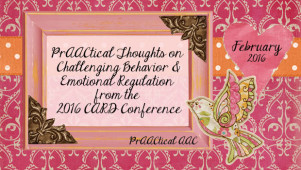
Last month, I had an opportunity to hear Dr. Barry Prizant, Director of Childhood Communication Services and Adjunct Professor at Brown University, at the 2016 Center for Autism and Related Disabilities Conference. Many of you know Dr. Prizant as co-author of SCERTS, the Social Communication Emotional Regulation Transactional Supports Program, and his recent book, Uniquely Human, discussed in this video. At this conference, he spoke on ‘An Emotional Regulation Approach to Preventing Problem Behavior.’ Here are some points of interest from his presentation. Dr. Prizant suggested that when someone is dysregulated, the first thing we should think about is biological factors that may be causing or exacerbating the problem. Why? Because unless we address the root of the problem, chances are slim that any behavioral, communicative, or psychological strategies will be effective in the long run. In some cases, there is a rather straightforward solution, such as teaching our client... [Read More...]
January 18, 2016
by Carole Zangari -
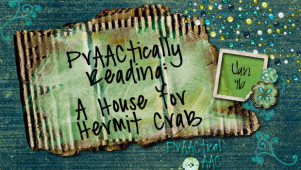
Storybook reading is rich with potential for building AAC, language, and literacy skills. An added bonus: It’s an activity that educators, therapists, and families can all use and enjoy. In this post, we explore ways to use A House for Hermit Crab, by Eric Carle, for AAC and language learning. Key Instructional Strategies Having an engaging book gives us a good start on the lesson, but the learning comes from the interaction. Shared reading can be done in therapy one-on-one or as a group in class. Either way, the adult leading the activity will need to be well-versed in instructional strategies that facilitate AAC learning. These include: Aided language input RAAP Feedback Goal Areas: Language and Communication There are lots and lots of ways to use this book for literacy learning, but in this post we’ll focus more on the development of communication and language skills. Here are some goal... [Read More...]
December 31, 2015
by Carole Zangari -

Goodbye, December! Before we turn the calendar page, here are some of the most popular posts of 2015. Many thanks to Lauren Enders, Rachael Langley, and all of our guest bloggers for being so generous with their time and expertise. I couldn’t do it without you!! 5 Great Resources for Pre-Made Communication Boards How I Do It: Writing IEP Goals for Students Who Use AAC with Lauren Enders How I Do It by Rachael Langley – PODD in the Classroom: Portable, Wearable, & Comfortable How I Do It: Using PODD books and Aided Language Displays with Young Learners with Autism Spectrum Disorder Core Samples Teaching Core Vocabulary A Year of Core Vocabulary Words Pivotal Skills for AAC Intervention: Aided Language Input Literacy for Everyone with Adapted Books Communication Boards: Colorful Considerations 30 Ways to Celebrate Autism Awareness Month
November 25, 2015
by Carole Zangari -
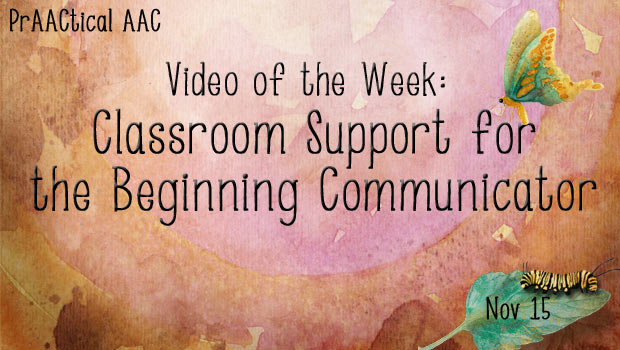
Gabriella doesn’t seem to notice what her teachers and peers are doing in the classroom. When offered a choice of toys, she seems to reach for one rather randomly, has little interest in the one she chose, and knocks it to the floor after 30 seconds. Elliot is assertive in greeting visitors to his classroom, and eagerly leads them around the room, vocalizing excitedly as he shows them around. When he needs help with a toy or material, he hands it to an adult with clear intent and expectation. He’s not using actual words just yet, and his interest in PECS has been limited. Alyssa uses a communication board to make requests and answer questions, but only with a lot of prompting. She uses single symbol utterances in planned communication opportunities during a few activities during the school day. Team members have observed spontaneous use of her AAC tools a... [Read More...]
November 24, 2015
by Carole Zangari -
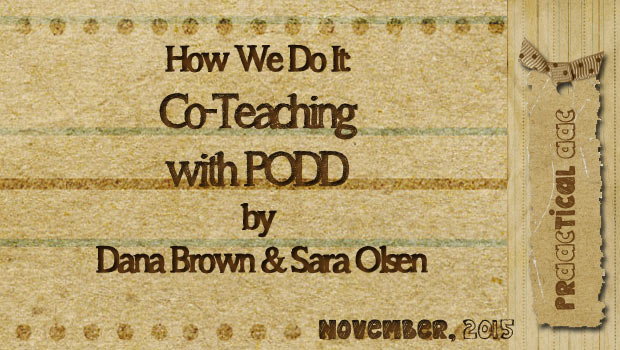
When SLPs and teachers work together for the benefit of students with little or no functional speech, the results can be magical. Today, we travel to Wisconsin to visit with SLP Dana Brown and Special Educator Sara Olsen who work together at the elementary school level. In this post, Dana and Sara tell us about their experiences using PODD in a classroom of students with intellectual disability. You can learn more about their work on YouTube (Watch Your Language) where they post Word of the Week videos and snippets of AAC use in different clasroom activities. Regular readers know that we’ve posted a few articles and videos on PODD. ::::::::::::::::::::::::::::::::::::::::: We write as a team of special educators, a Speech Language Pathologist (SLP) and an Intellectual Disabilities teacher, and one thing that we’ve learned working closely together is that AAC is difficult and ongoing. In this post, we are excited to share... [Read More...]
November 19, 2015
by Carole Zangari -
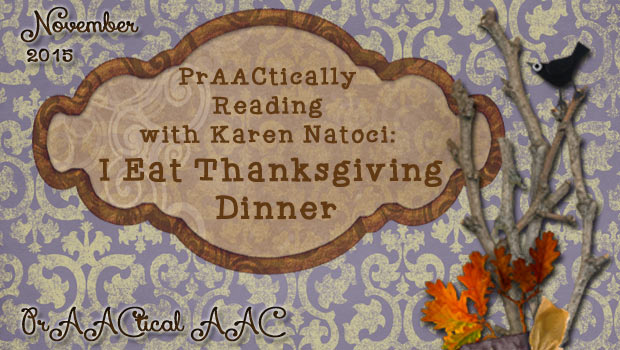
Here in the US, many are getting ready for the Thanksgiving holiday. If you’re looking for a way to add a prAACtical dimension to your preparations, this post is for you. Thank you, Karen Natoci, for another fabulous PrAACtically Reading contribution! :::::::::::::::::::::::::::::::::::::::::::::::::::::::::::::::::::::::::::::::::::::::::::::: Book: I Eat Thanksgiving Dinner by Karen Natoci; Published on Tarheel Reader here. Core Vocabulary focus: LIKE, DON’T LIKE, Uh Oh!, I, MORE, IT, COMMUNICATION Matrix Level: I-VII Literacy Framework: Emergent This month, we decided to practice eating Thanksgiving Dinner by “eating” our way through this book! This has been uploaded to Tarheelreader and the powerpoint version is available there. This is shared around a table set for a feast! To prepare for this story, we were able to purchase a frozen thanksgiving dinner available at the grocery store. We heated it up and separated it into serving dishes, individualized according to the diet of each of our readers. Some... [Read More...]
November 9, 2015
by Carole Zangari -
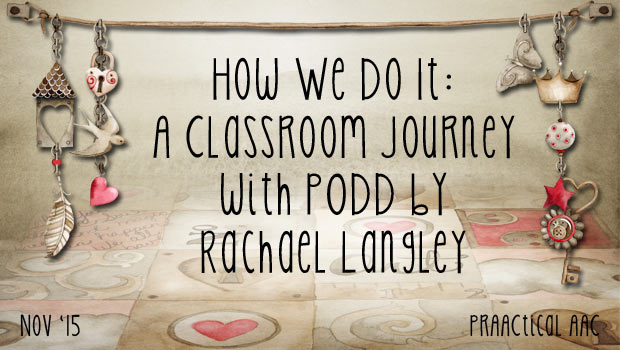
Let’s face it. Good AAC implementation takes commitment and requires a lot of effort from those who are with the AAC learners throughout the day. Sometimes an AAC tool or strategy that seemed promising at first, doesn’t pan out to be as successful as expected. Other times, it’s a challenge to keep up with the demands of the classroom, therapy session, and life and still find the energy to consistently implement good AAC practices. In the real world, teams struggle with these issues every single day. So when Rachael Langley, a Michigan-based SLP and AAC specialist, offered to provide insight into what that process has been like in classrooms she supports, I was thrilled. Rachael’s original post about using PODD in the classroom and her follow-up post on implementation tips gave us insight into the journey that one elementary school classroom team is taking to better serve their students with little or no... [Read More...]
November 2, 2015
by Carole Zangari -
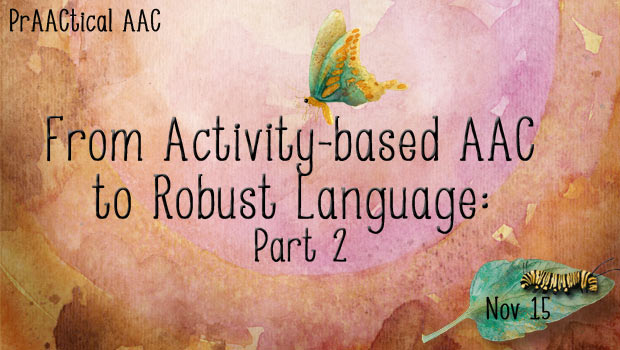
Last week, we talked a bit about activity-based communication displays (ABCDs), and the role they play for AAC learners. The analogy of feeding someone (with ABCDs) versus teaching them to fish for themselves (with robust AAC), resonated with many of you. In some cases, ABCDs can be a good way for therapists, educators, and families to take steps forward in their implementation of AAC. They allow students with little or no functional speech a way to participate in activities by making choices and comments, and that is a very good thing for those who don’t have a better option. There are a few drawbacks to ABCDs, though. Here are some of them. ABCDs limit language development. The learner can only experience the exact words and configurations that appear on a particular display. The learner has no way to expand his/her utterance by including other words or concepts. ABCDs are time-consuming... [Read More...]
October 27, 2015
by Carole Zangari -
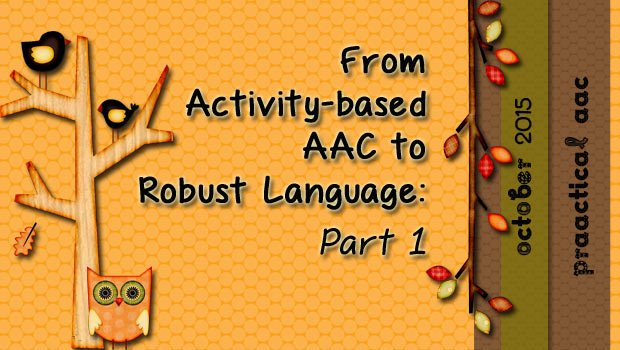
As far as I can tell, most AAC learners are taught by people who don’t specialize in AAC. Their school SLPs may have caseloads of 50, 60, 70, or more students with IEPs, 90% of whom have goals for articulation, language, and fluency. Their classroom teachers serve students whose disabilities range from none at all, to dyslexia to cerebral palsy, to significant intellectual disabilities, and everywhere in between. In all likelihood, neither group had much AAC training. What little AAC they know, they’ve picked up on their own from reading, going to workshops and conferences (usually self-funded), talking to colleagues, and exploring online resources. Many times, their first foray into AAC is with things like choice boards and visual supports, such as daily schedules and first/then boards. From there, they may begin labeling the environment with pictures symbols (e.g., ‘table’ on the table, ‘on/off’ near the light switch), using mini-schedules... [Read More...]
October 15, 2015
by Carole Zangari -
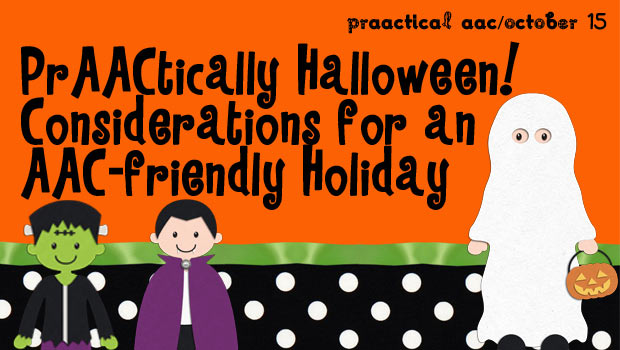
Holidays are special and Halloween is a favorite among many. As much fun as it is to dress up and get candy, though, there are lots of ways that Halloween can be stressful for AAC learners. From the change in routine, to the costumes and scary decorations, to talking with neighbors and other less familiar communication partners, to the over-abundance of sugar, there are lots of ways in which Halloween can trip us up. If the AAC learners in your life celebrate Halloween, Fall Festival, Harvest Parade, or any other celebration with similar traditions, we SLPs can help them to have a positive experience. Here are some ideas. Use a social narrative to prepare everyone for what to expect on and around Halloween. Read them often in the weeks leading up to the school dress-up parade, party, and the big day itself. More Halloween social narratives can be found at Therapics,... [Read More...]









